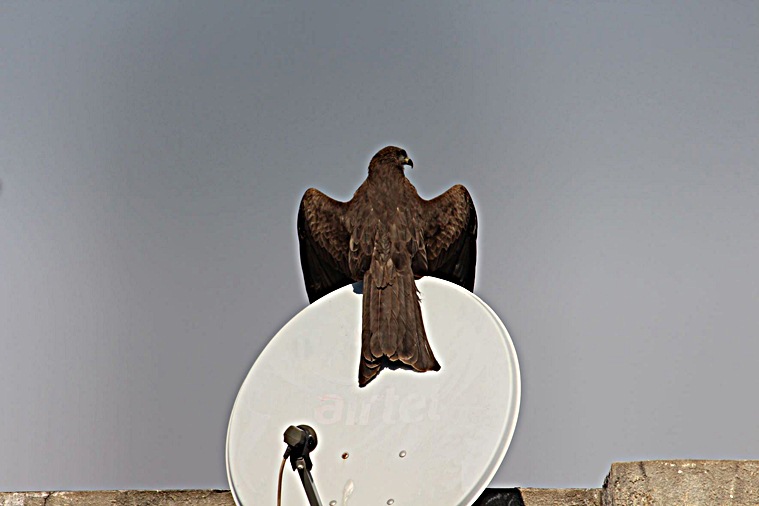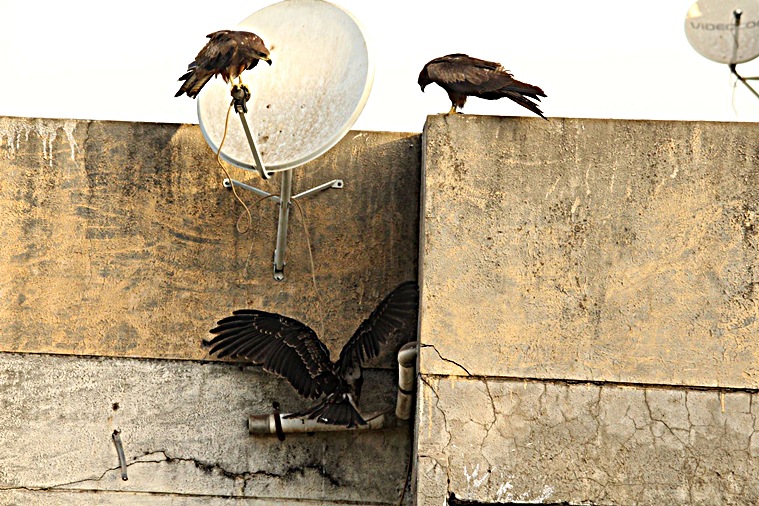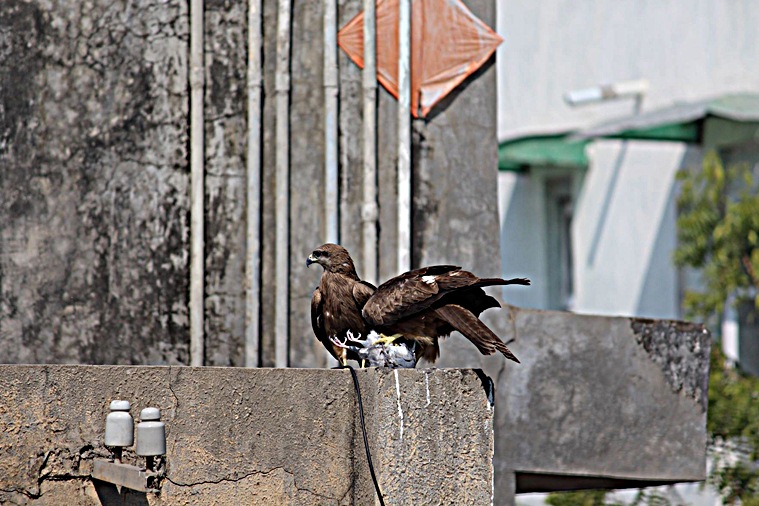Have you noticed those medium-sized black birds soaring in the skies over your city and making shrill ‘chii-hihihi-chii-hihihi’ calls that may sound like the neighing of a horse in pattern? Have you seen them perching on terraces of high-rises and communication and electricity towers and sometimes being engaged in fights with crows? These master fliers that have adapted to cityscapes are black kites, a bird of prey unfazed by human presence.
Being hunters, most birds smaller in size fear black kites. However, crows, the smart and intelligent birds, often harass these raptors. Crows tease black kites during the latter’s mating season and even prey on the raptors’ eggs. Therefore, many a time, the black kites, which belong to the Accipitridae family of birds which also includes hawks, eagles, harriers, and Old World vultures, among others, are seen chasing away crows.
 Black kite (Scientific name: Milvus migrans) is called samdi or shiyalu samdi in Gujarati. It is a medium-sized bird of prey. It is a very common bird in Ahmedabad and most big cities in India, where the population of pigeons is large – as kites hunt them. It is difficult to distinguish between a male and a female of black kites because they both look similar. The only difference is that the female is longer than a male and her wingspan is larger than that of a male. They have a dark brown body, blackish grey hooked beak, yellow colour around the nostrils, yellow gape-line and feet, and brown iris with black pupils. Its tail looks slightly forked. Some of the upper body feathers have a white shade or lighter brown towards the end.
Black kite (Scientific name: Milvus migrans) is called samdi or shiyalu samdi in Gujarati. It is a medium-sized bird of prey. It is a very common bird in Ahmedabad and most big cities in India, where the population of pigeons is large – as kites hunt them. It is difficult to distinguish between a male and a female of black kites because they both look similar. The only difference is that the female is longer than a male and her wingspan is larger than that of a male. They have a dark brown body, blackish grey hooked beak, yellow colour around the nostrils, yellow gape-line and feet, and brown iris with black pupils. Its tail looks slightly forked. Some of the upper body feathers have a white shade or lighter brown towards the end.
 Black Kite basking in the sun. (Photo by Shefali Trushit Naik)Calls of black kites are heard a lot in winter because winter is the mating season of these birds. From early morning they are often heard making those shrill ‘chii-hihihi’ calls, very similar to that of a woodpecker.
Black Kite basking in the sun. (Photo by Shefali Trushit Naik)Calls of black kites are heard a lot in winter because winter is the mating season of these birds. From early morning they are often heard making those shrill ‘chii-hihihi’ calls, very similar to that of a woodpecker.
Black kites prefer sunny hot places and, therefore, are found more in dry hot places like Ahmedabad and Delhi. They prefer to roost in groups. One such site is the Ahmedabad University campus where one can find around 150 black kites roosting together in the evenings.
Many times, an aerial courtship display, called talon-grappling, is performed by black kites (both males and females) to attract the partner. They call each other loudly, lock their talons, and fall freely, spinning or tumbling or cartwheeling from a height. It is quite amazing to watch such a display which involves lots of acrobatics. Once they choose their partners, the male strolls for a few minutes to where the female is, and then both mate. This period is shorter as compared to other birds. They build their nest on a tree at a height from where three-four thick branches are emerging. Because the bird itself is big in shape, it needs a big and strong nest to hatch the eggs. Hatchlings also stay for about 45 days in the nest. So, they also need space.
To build a strong nest, a black kite uses large and thick twigs, strings, pieces of clothes, hays, etc. It lays two to three eggs at a time. Males and females both participate equally in parenting. They build the nest, hatch the eggs, bring food, and take turns to keep a watch on the nest. The eggs and hatchlings of a black kite are at risk because of crows. Due to the large size of the nest and the black kite itself, it comes into the sight of the crows. The crows watch when the eggs are laid, the chicks hatch and often prey on them. Apart from this, black kite’s kills are also a blessing for crows. After a black kite eats its prey and flies away, the crows eat the residue of such prey. During their mating season, the crows harass black kites by pecking them. So black kites chasing crows is a rather common sight during winter.
Advertisement
 Parent kites watching their young one as the latter tries to fly. (Photo by Harsheev Trushit Naik)In winter, black kites open their wings and bask in the sun. Both males and females are seen sharing and eating food together. Black kites are scavengers, but they also hunt. The food of black kites is other small birds, especially pigeons. Ahmedabad has a good population of pigeons. Before a pigeon knows anything, it becomes prey of black kites because pigeons are by nature naïve (or rather dumb), slow-moving, and remain in large flocks. So, black kites hunt them easily. Apart from this, these raptors also prey on mice, snakes, lizards, and other small birds. Black kites are very vocal birds. Mostly they hunt individually but a flock of them can also execute a well-coordinated counterattack when they feel threatened.
Parent kites watching their young one as the latter tries to fly. (Photo by Harsheev Trushit Naik)In winter, black kites open their wings and bask in the sun. Both males and females are seen sharing and eating food together. Black kites are scavengers, but they also hunt. The food of black kites is other small birds, especially pigeons. Ahmedabad has a good population of pigeons. Before a pigeon knows anything, it becomes prey of black kites because pigeons are by nature naïve (or rather dumb), slow-moving, and remain in large flocks. So, black kites hunt them easily. Apart from this, these raptors also prey on mice, snakes, lizards, and other small birds. Black kites are very vocal birds. Mostly they hunt individually but a flock of them can also execute a well-coordinated counterattack when they feel threatened.
Despite all their powerful flight, mid-air manoeuvrability, and hunting skills, black kites, the hunters, become prey of more powerful hunters like Eurasian eagle-owls.
The chicks of black kites are grey in color when born. Gradually they look brownish as their feathers develop. When it is time to fly, the chicks leave the nest and walk four to five steps on the branch, sit there for a while, and come back to the nest. This they do for about 15 days. Gradually they increase the walking distance and start flapping their wings. When they have the confidence to fly, they sit on the edge of a branch and take off. But initially, their flights are short. They fly a little and sit on a nearby tree or terrace. After a while, fly again a small distance and rest. Finally, they fly forever. Until the chicks take their first flight, the parents keep a watch over them from a distance. If another bird or cat comes to harm the chicks, they chase it away.
From the time of egg laying till the chicks move out of the nest, the black kite is seen doing the same daily work. The time to come out and go to the nest, the time to sit on the branch outside the nest and its duration, the time to bring food, the way they enter the nest, and the time to fly around in the sky at different heights are all the same. If you are doing any research about a black kite, it will never disappoint you. It follows its daily routine in such a way that if you miss something to record or forget to write, you can do it the next day. But this is as long as the eggs and chicks are in the nest. Once the chicks leave the nest, they too leave the nest and do not return.
Advertisement
Black kites are seen soaring very high in the sky, maybe because they need less energy at height or the temperature is favorable. Their eyes are very sharp like other birds of prey. What a natural surveillance system it is! During their breeding season, black kites remain very vigilant, attacking not only other birds and animals that try to intrude on their nests but also humans with their beaks, thinking they would harm the nest and chicks. No matter where it comes from, in a moment it flies away quickly after pecking the animal or on the head of humans. In Gujarati, the word ‘cheelzadap’ is used as a metaphor which describes a person snatching something away from the other as speedily as a black kite.
 Black Kites eating a pigeon. (Photo by Harsheev Trushit Naik)A black kite basks in the sun with its wings spread in winter to rapidly raise its body temperature. It keeps its back in the direction of the sun while doing this. This pose is called a horaltic pose. Black kite is often seen opening and closing its beak which looks like it is doing face yoga or yawning. While doing this it also moves its head up and down. It walks like a king from one end to the other on a flat surface such as a parapet.
Black Kites eating a pigeon. (Photo by Harsheev Trushit Naik)A black kite basks in the sun with its wings spread in winter to rapidly raise its body temperature. It keeps its back in the direction of the sun while doing this. This pose is called a horaltic pose. Black kite is often seen opening and closing its beak which looks like it is doing face yoga or yawning. While doing this it also moves its head up and down. It walks like a king from one end to the other on a flat surface such as a parapet.
Filmmaker Shaunak Sen made a documentary named ‘All That Breathes’, which describes the story of two brothers in Delhi who are fighting to rescue the city’s injured black kites. The documentary was nominated in the Best Documentary Feature Film category at Oscars 2023. As published in 2022 by The Indian Express, a collapsed dehydrated black kite was rescued from Prime Minister Narendra Modi’s official residence in Delhi.
The International Union for Conservation of Nature (IUCN) red list of threatened species lists the Black Kite as a species of least concern.
(Shefali Trushit Naik is an assistant professor at the School of Engineering and Applied Sciences, Ahmedabad University, and a birdwatcher)





